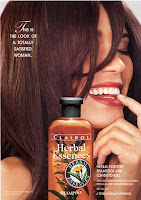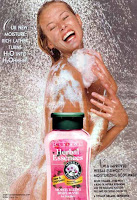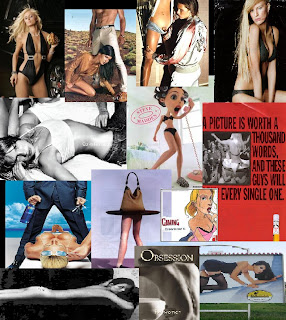My Autobiographical Blogging Experiences
Throughout the year, I can honestly say that my blog has had a severe analytical evolution in the way that I analyze and the things that I analyze. I went from analyzing gender in just mediocre facial ads to analyzing gender in ads concerning the whole bodily sense. However, my interest in this subject matter did not just come from taking the Gender and Pop Culture course, but instead came from my fascination with fashion magazines.
I first started to realize how these advertisements in teen magazines affected my thought process when it came to how I felt about my body. I notice that I would look to these images consistently as to how I should look; the models looked happy and I wanted to be happy looking like them. However, taking several gender courses before Gender and Pop Culture helped me to realize that, that was all bogus.
It started to occur to me that these ads were merely a manipulation to sell products, and women were the main objectives in selling products; and my class helped spark that idea. From there, my blog has developed and raised awareness of how gender is represented in advertisements and how mainly men and teen girls are affected by these stereotypical images, as men look to them for a ideal mate and girls look to it for a bodily ideal.
I now understand and think differently about advertisements in general. I notice it everywhere I go and that only increases my knowledge and perceptions everyday. After presenting on my blog I realized how much I have learned and grown since my Gender and Pop Culture course, and how I can use the skills I obtained in the real world, in analyzing pop culture. :)
Friday, May 4, 2007
Tuesday, April 24, 2007
Sunday, April 22, 2007
Blog Critique
Michelle's Comments for My blog:
My Comments for Michelle's Blog :
1. Your posts on “Commercials in the News” and “The Conflict of Appearance in Women through Commercials” are a very strong and analytical and provide very insightful and useful information in viewing commercials and advertisements.
2. A good way to use these post for your final blog post would be to make a timeline on how images of women (and/or men) have changed since commercials were first aired to today’s average commercial. You could also use the video blogging as an extra oomph to your final blog assignment.
3. It is obviously evident that you feel strongly about what you write about and I can see how your blog as evolve from your first “Links about my Blog” to “Commercials in the News” and can also be a great idea for your final blog presentation.
4. I think that your posts make strong critical arguments on how gender is depicted in your everyday commercial and how ignorant people are to the stereotypes that are unconsciously engraved in these commercials. I also appreciate how the links and sources you use help the reader become more identified to the argument you are making.
5. I thought it was great how you observed and analyze the Snickers Commercial. Your argument really made me angry in the sense that I wanted to send the company a letter ...even though they probably stopped airing the commercial by now. J
Hope this helped!!
My Comments for Michelle's Blog :
1. Your posts on “Commercials in the News” and “The Conflict of Appearance in Women through Commercials” are a very strong and analytical and provide very insightful and useful information in viewing commercials and advertisements.
2. A good way to use these post for your final blog post would be to make a timeline on how images of women (and/or men) have changed since commercials were first aired to today’s average commercial. You could also use the video blogging as an extra oomph to your final blog assignment.
3. It is obviously evident that you feel strongly about what you write about and I can see how your blog as evolve from your first “Links about my Blog” to “Commercials in the News” and can also be a great idea for your final blog presentation.
4. I think that your posts make strong critical arguments on how gender is depicted in your everyday commercial and how ignorant people are to the stereotypes that are unconsciously engraved in these commercials. I also appreciate how the links and sources you use help the reader become more identified to the argument you are making.
5. I thought it was great how you observed and analyze the Snickers Commercial. Your argument really made me angry in the sense that I wanted to send the company a letter ...even though they probably stopped airing the commercial by now. J
Hope this helped!!
Thursday, April 12, 2007
“News and Gender” in Advertisements: Fashion Ads Touch a Nerve in Gender-conscious Spain
This news article by Victoria Burnett, issued from the International Herald Tribune, entitled Fashion Ads Touch a Nerve in Gender-conscious Spain is about how Spain is taking the initiative to ban and prohibit gender stereotypes in advertisements and fashion clothing stores.
The article mentions Jose Luis Rodriguez Zapatero and his government on how they are intervening in “public and commercial life to try to change Spain’s macho culture” that seems to continue to oppress women.
As mentioned my Burnett, certain Giorgio Armani and Dolce & Gabbana advertisements deemed as sexists toward women and have disturbed society, especially Spanish women consumers. One particular advertisement that showed two girls with makeup and bikinis disturbed Madrid’s ombudsman saying that “It’s not dissimilar to the pictures that circulate on the Internet promoting sex tourism.”
Burnett also mentions in the article that due to these female gender stereotypes, the Spanish Health Ministry has campaigned to measure 8,000 women for a better ideal on the “average” women’s size for clothing and mannequins in top Spanish fashion companies.
The article mentions Jose Luis Rodriguez Zapatero and his government on how they are intervening in “public and commercial life to try to change Spain’s macho culture” that seems to continue to oppress women.
As mentioned my Burnett, certain Giorgio Armani and Dolce & Gabbana advertisements deemed as sexists toward women and have disturbed society, especially Spanish women consumers. One particular advertisement that showed two girls with makeup and bikinis disturbed Madrid’s ombudsman saying that “It’s not dissimilar to the pictures that circulate on the Internet promoting sex tourism.”
Burnett also mentions in the article that due to these female gender stereotypes, the Spanish Health Ministry has campaigned to measure 8,000 women for a better ideal on the “average” women’s size for clothing and mannequins in top Spanish fashion companies.
Wednesday, April 11, 2007
Why Gender in Ads? What My Blog is Really About...
My blog is about the daily advertisements that are socially constructing the images and ideas of gender while being portrayed through the media. In this blog I will compare and contrast the gender representations that the media displays through these advertisements. At first I only started this blog simply because it was a course requirement for my class Gender and Pop Culture. However, being that I am very interested in what advertisements have to say about the way people should live (what's in and what's not), I chose this topic for my blog because I want to reflect on the everyday gender stereotypes that people do not normally see because they are blinded by the clichés of society.
As obvious as it truly is, advertisements are everywhere and used to each companies advantage. Most advertisements are well thought out and planned to enhance the companies profits and publicity; even if that means having to break a few backs (or say perhaps innocent minds) just to make a million dollars. However, it's not the adults or elderly that are mainly affected by these gender stereotypes, it's the children and teens that are looking to these images in determining their own identity, i.e., sex, nymphomania, women consumers. In his article, Cultural Studies, Multiculturalism, and Media Culture, Douglas Kellner states “Media Culture provides the materials for constructing views of the world, behavior, and even identities. Those who uncritically follow the dictates of media culture tend to ‘mainstream’ themselves, conforming to the dominant fashion, values, and behavior”. The young people of today are the ones who are “tending” to materials given by these gender stereotypes in advertisements, showing them what to look like, how to dress, and how to behave.
Many advertisements, such as Herbal Essence, demonstrate women and femininity as a symbol of chaste sexuality; in other words, nymphomania. Some advertisements show women having orgasmic reactions to simple hair and body wash. For example, one slogan for Herbal Essence body wash says “Our New Moisture-Rich Lather Turns H2O into H2Ohhhh!” This also shows a half naked woman, only covering her breasts and vagina, which appears to show the woman as happily laughing and enjoying the body wash. Another Herbal Essence advertisement for hair wash shows a woman with a big smile, finger in her mouth, hair over her face, and eyes closed. The slogan for this particular advertisement says “This is the look of a totally satisfied woman.” What are these advertisements really saying to young people? Is this sending out a negative message, that women are clueless nymps who have orgasms to body wash and shampoo? Need I say anything else?
What is most important is who is looking at these advertisements. Consequently, if every little person is looking to these images then society will not progress in changing the minds of people who unconsciously stereotype gender; scholars, professors, and college students alone can not stop these stereotypical images. (These are the kind of issues in advertisements that I will be addressing in my blog.)
Kellner, Douglas. "Cultural Studies, Multiculturalism, and Media Culture." Gender, Race, and Class In Media (2003): 9-19.


Thursday, April 5, 2007
How To Read Ads.... See What I See? (thanks to research team)
Here is an excerpt from GenderAds.com  on how to read and go about analyzing gender in ads portraying male and/or female in a negative light. There are six ares/levels of analysis in looking at ads. Enjoy... :o)
on how to read and go about analyzing gender in ads portraying male and/or female in a negative light. There are six ares/levels of analysis in looking at ads. Enjoy... :o)
Area I: Basic Analysis of the Layers of Meaning in Ads
[Katherine Frith (1998)] discusses a tripartite approach to reading advertising. The examples below follow her understandings of ads in "Undressing the Ad: Reading Culture in Advertising.
Area II: Semiotic Analysis of Ads
Erving Goffman's classic Gender Advertisements (1979) offers a semiotic analysis of advertising. Goffman's analysis looks at the specific codes present in ads and considers what they say about society and social relationships. His study includes a focus on minute details of ads, visual composition of ads, as well as the presence of specific social themes in ads.
Area III: Thematic Analysis of Ads
In Advertising and the End of the World director Sut Jhally focuses on the negative impacts of advertising on our social relations and the environment. He develops a specific analysis of ads that draws the viewer to make holistic conclusions about the totality of the advertising industry. This holistic approach includes considerations of how a majority of ads stress specific visions of society, focus on how products produce happiness in consumers and project a vision of the future. Thus, another way to read ads is to consider the themes that develop in a specific medium, such as a Vogue magazine, or across a number of issues of that magazine or even across a broad spectrum of multiple magazines. This web page is focused on this holistic analysis of the themes that appear in popular advertisements. Jhally's other significant work, Dreamworlds II, also influenced a number of the themes that can be found in both music videos and popular magazine ads.
Area IV: Quantitative Analysis of Ads
Quantitative analyses of ads focus on the number of ads that represent a particular theme in the study. For example, one might conduct an analysis of the various forms of representation, techniques of presentation and thematic issues present in male and female sports magazines. A quantitative assessment of the numbers of any of these items would give a relative indication of the social constructions present in the advertising.
Area V: Side-By-Side Comparisons of Ads
This approach to ads would use two or more ads in a comparative sense to understanding differences in the constructions of gender and sexuality in ads. A goal of this form of analysis is to understand content and thematic differences in visual representations.
Area VI: Ethnographic Analysis of Ads
An ethnographic analysis of ads would include (1) interviews with ad or media agency representatives as to the goals of their advertising campaigns, (2) interviews with everyday individuals to assess their understandings of the meanings of ads.
 on how to read and go about analyzing gender in ads portraying male and/or female in a negative light. There are six ares/levels of analysis in looking at ads. Enjoy... :o)
on how to read and go about analyzing gender in ads portraying male and/or female in a negative light. There are six ares/levels of analysis in looking at ads. Enjoy... :o)Area I: Basic Analysis of the Layers of Meaning in Ads
[Katherine Frith (1998)] discusses a tripartite approach to reading advertising. The examples below follow her understandings of ads in "Undressing the Ad: Reading Culture in Advertising.
Area II: Semiotic Analysis of Ads
Erving Goffman's classic Gender Advertisements (1979) offers a semiotic analysis of advertising. Goffman's analysis looks at the specific codes present in ads and considers what they say about society and social relationships. His study includes a focus on minute details of ads, visual composition of ads, as well as the presence of specific social themes in ads.
Area III: Thematic Analysis of Ads
In Advertising and the End of the World director Sut Jhally focuses on the negative impacts of advertising on our social relations and the environment. He develops a specific analysis of ads that draws the viewer to make holistic conclusions about the totality of the advertising industry. This holistic approach includes considerations of how a majority of ads stress specific visions of society, focus on how products produce happiness in consumers and project a vision of the future. Thus, another way to read ads is to consider the themes that develop in a specific medium, such as a Vogue magazine, or across a number of issues of that magazine or even across a broad spectrum of multiple magazines. This web page is focused on this holistic analysis of the themes that appear in popular advertisements. Jhally's other significant work, Dreamworlds II, also influenced a number of the themes that can be found in both music videos and popular magazine ads.
Area IV: Quantitative Analysis of Ads
Quantitative analyses of ads focus on the number of ads that represent a particular theme in the study. For example, one might conduct an analysis of the various forms of representation, techniques of presentation and thematic issues present in male and female sports magazines. A quantitative assessment of the numbers of any of these items would give a relative indication of the social constructions present in the advertising.
Area V: Side-By-Side Comparisons of Ads
This approach to ads would use two or more ads in a comparative sense to understanding differences in the constructions of gender and sexuality in ads. A goal of this form of analysis is to understand content and thematic differences in visual representations.
Area VI: Ethnographic Analysis of Ads
An ethnographic analysis of ads would include (1) interviews with ad or media agency representatives as to the goals of their advertising campaigns, (2) interviews with everyday individuals to assess their understandings of the meanings of ads.
Thursday, March 29, 2007
Sexy Selling Ads Means Women Being Partly Naked, Thin, and Submissive to Men...?
I am beautiful as I am. I am the shape that was gifted. My breasts are no longer perky and upright like when I was a teenager. My hips are wider than that of a fashion model's. For this I am glad, for these are the signs of a life lived. ~Cindy Olsen, co-owner of The Body Objective


This collage shows advertisements that degrade and lower women as individuals and depict them more as property, and under subjection to men. It shows how the media, along with pop culture, uses these images to depict what every “real” woman is suppose to look like. Have you ever seen normal woman in your area that look like this, and are being questioned if they’re having health issues and being held on a lease by a man? These advertisers use models that look unhealthy and extremely skinny, as sexy selling products. They also use today’s computer technologies to “erase” the “flaws” of these models to make their advertisements seem more appealing and more attractive to men; when in fact, it’s only causing our young woman to strive to look like this (which is almost impossible to look anorexic and be healthy at the same time) despite making awfully unhealthy decisions.
Labels:
ads,
advertisments,
gender,
product,
sex symbol,
women
Wednesday, March 7, 2007
Gender Bending But Not Breaking: The Displacement of Objectification in Super Bowl Advertising by Bernie
Bernie's Blog (excerpt)
At first glance, this year's Super Bowl ads appeared to avoid, almost entirely, the objectification of women that has been the hallmark of previous broadcasts. While the trend has been heading this way the last few years (reflecting, possibly, an attempt to appeal to growing female audience), as recently as last year we found plenty to talk about.
This year perceptive critics like Steven Johnson didn't even mention any portrayals of women, noting, instead, that "the strangely dominant theme of the night's ads was the undertone of violence."
Gender, though, played a role throughout the night -- even if it was hidden behind closed doors or behind role reversals.
The only company that took the old-fashioned route was Go Daddy. Even their ad, however, included elements of ironic self-awareness of the straight-up exploitation of their previous Super Bowl ads. A well-coiffed executive tells us about all the great parts of the company, but when he opens the door to the marketing department, it reveals a party of over-the-top excess, featuring their "Go Daddy Girl" from previous years as well as an assortment of ridiculous, offensive partygoers.
My Response
Your analytical interpretation definitely raises questions and concerns about the negative portrayals of women and men in advertisements in general, not just super bowl ads. These companies really have a lot of nerve thinking that gender can be intermediated in ads without taking gender issues over the limit; there is no compromising when it comes to gender and companies can not just do and say what they please when it comes to gender.
However, by incorporating ads that “mock masculinity” we aren’t nipping the problem of gender stereotypes, but we’re reinforcing it. The ad for Chevy HHR is a great commercial when it comes to role reversing in gender representation. If I had seen men in the Chevy and woman running toward the car prancing and panting over the car, I would have been very upset at the negative portrayal of women as idiotic and superficial for behaving that way over a car. But, since it was the opposite, I did not care to think twice; which can also be counted for as a negative portrayal of men, assuming that all men go goo-goo-ga-ga over cars.
At first glance, this year's Super Bowl ads appeared to avoid, almost entirely, the objectification of women that has been the hallmark of previous broadcasts. While the trend has been heading this way the last few years (reflecting, possibly, an attempt to appeal to growing female audience), as recently as last year we found plenty to talk about.
This year perceptive critics like Steven Johnson didn't even mention any portrayals of women, noting, instead, that "the strangely dominant theme of the night's ads was the undertone of violence."
Gender, though, played a role throughout the night -- even if it was hidden behind closed doors or behind role reversals.
The only company that took the old-fashioned route was Go Daddy. Even their ad, however, included elements of ironic self-awareness of the straight-up exploitation of their previous Super Bowl ads. A well-coiffed executive tells us about all the great parts of the company, but when he opens the door to the marketing department, it reveals a party of over-the-top excess, featuring their "Go Daddy Girl" from previous years as well as an assortment of ridiculous, offensive partygoers.
My Response
Your analytical interpretation definitely raises questions and concerns about the negative portrayals of women and men in advertisements in general, not just super bowl ads. These companies really have a lot of nerve thinking that gender can be intermediated in ads without taking gender issues over the limit; there is no compromising when it comes to gender and companies can not just do and say what they please when it comes to gender.
However, by incorporating ads that “mock masculinity” we aren’t nipping the problem of gender stereotypes, but we’re reinforcing it. The ad for Chevy HHR is a great commercial when it comes to role reversing in gender representation. If I had seen men in the Chevy and woman running toward the car prancing and panting over the car, I would have been very upset at the negative portrayal of women as idiotic and superficial for behaving that way over a car. But, since it was the opposite, I did not care to think twice; which can also be counted for as a negative portrayal of men, assuming that all men go goo-goo-ga-ga over cars.
Wednesday, February 28, 2007
Gender Analysis of "The Girls Next Door"

The famous hit reality television show The Girls Next Door is about three young Playboy bunnies that live as the well-konwn girlfriends to Hugh Hefner, founder and owner of the Playboy industry. Just in case you haven’t seen the show, Holly, Hugh’s number one girl and his obvious favorite, is the oldest and most mature of the three girls; Bridgette is viewed as ditsy yet the only one going for her master’s degree and Kendra is the youngest and newest one of Hefner’s girlfriends.
These three girls live an open life in the Playboy mansion as they roam about nakedly revealing every aspect of their lives while viewers take in mind-blowing ideas and images on societal norms. This provocative show is perpetuating a message that supports the socially constructed images of femininity and masculinity by conveying the relationship between a father and daughter; Hefner and the girls.
For one, Hugh Hefner does not seem to treat his ‘girlfriends’ like they are his lovers. Instead, he exposes (well, at least on screen) a father-like role to the girls. He treats them like they are his daughters, which questions his dominance over them as a father and not a lover; he never kisses them in a lover-like passionate way, but instead gives them a kiss on the forehead or a peck on the lips.
Secondly, on-screen, the girls act differently when they are around each other versus when they are around Hefner. When the girls are together they are loose, energetic, crazy, and always seem to be having ‘girl fun’. However, when Hefner comes around, the girls seem better-behaved, angelic, and prance around as if they’re walking on clouds (ie, the whole Barbie-on-her-tip-toe icon). This is giving off a false image, or might I add, ‘false advertisement’, of how the relationship should be between a man and woman (s). In other words, all girls (daddy’s little girls) should respect their male lover the way they respect their fathers and listen to everything and do everything that the daddy says, sarcastically speaking.
This show sheds light on the social norms that the media portrays through shows like The Girls Next Door, insinuating what life is suppose to be like and what’s expected of people who live in this customary society. As Allan G. Johnson mentions in his article, Patriarchy, the System: An It, Not a He, a Them, or an Us, “It’s about the standards of feminine beauty and masculine toughness, images of feminine vulnerability and masculine protectiveness, of older men coupled with younger women (1).” That being said, why is this ‘false advertisement’ called 'reality T.V.?'
Johnson, Allan G.. "Patriarchy, The System: An It, Not a He, a Them, or an Us." The Gender Knot: Unraveling Our Patriarchy Legacy (1997): 91-99.
picture derived from: http://dvd.monstersandcritics.com/reviews/article_1186197.php/DVD_Review_The_Girls_Next_Door_%96_The_Complete_First_Season
Labels:
ads,
advertisments,
gender,
hugh hefner,
playboy,
playboy bunnies,
the girls next door
Sunday, February 18, 2007
Interesting Websites on Gender in Advertisements..
Here are some links to issues addressing Gender in Advertisement... I chose these certain sites because they will give some clarification as to why I am blogging on this particular subject. Maybe this (as in my blog) will motivate you to want to take notice on gender and your everyday advertisements... =:0)
- Woman and Men in Advertising: Narrative Illustration of an 'Equality which Can Not Be Found'
- The Impact of Gender on AD Processing: A Social Identity Perspective
- Gender in Advertising
- The Stanford Daily: Sony Ads Perpetuate Gender Stereotypes
- Gender Stereotypes in Portuguese Television Advertisements
Enjoy..
Thursday, February 15, 2007
A "Clear Complexion" is a Must for All Women...

It's funny how most ads on having a "clear complexion" over-exaggerate the scars and marks on a women's face as horrible and terribly unattractive. Having a clear complexion serves as a position in feminine beauty and hinders “normal” women who have to battle with the everyday scars they obtain from acne and blemishes. These ads represent having real beauty as having a pleasant face with no blemishes or marks. These images are crucial in the lives of everyday women who create in themselves low self esteem/standards by turning the pages to a magazine and seeing this ad… believing that they are not beautiful because they have a few scars on their faces.
Labels:
ads,
advertisments,
beauty,
gender,
represestation,
women
Subscribe to:
Posts (Atom)



